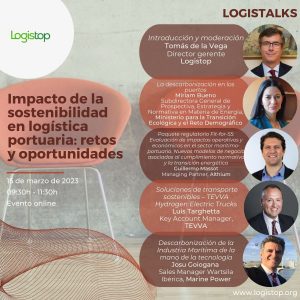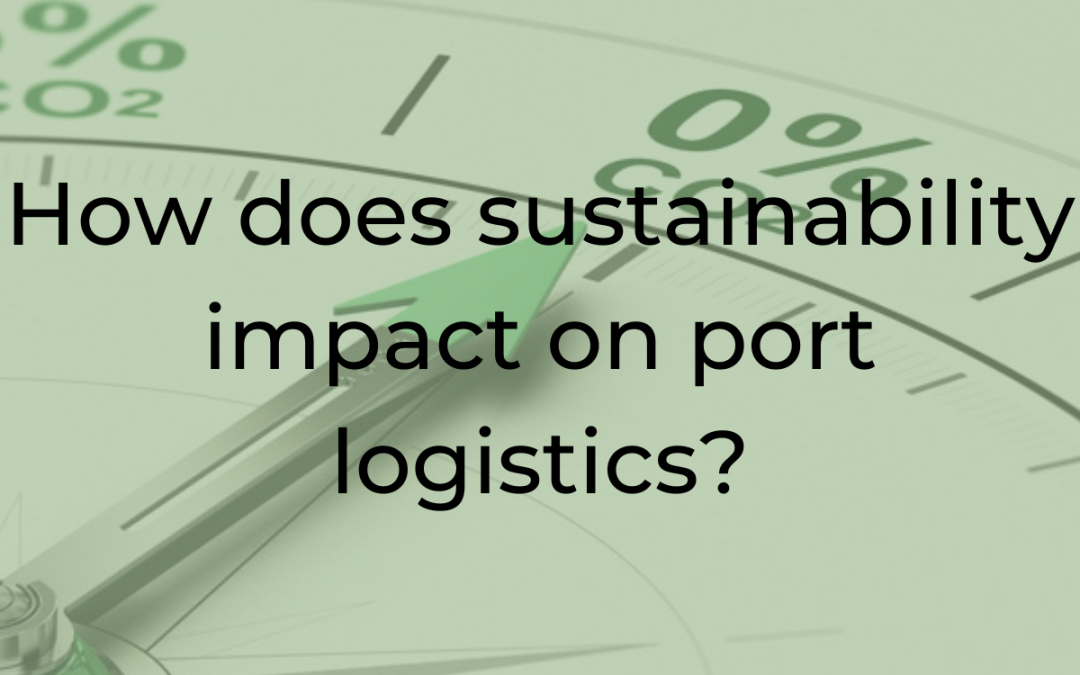- Decarbonisation needs to be addressed comprehensively in the maritime sector.
- In the future, ports will have to adapt to the use of a fuel mix.
Logistop has organised the LogisTalks online event “Impact of sustainability in port logistics: challenges and opportunities” in which, together with experts in the field, we have analysed the impact that sustainability has on port logistics, focusing on the challenges and opportunities it offers the sector.
Miriam Bueno, Deputy Director General for Energy Foresight, Strategy and Regulations, Spanish Ministry for Ecological Transition and the Demographic Challenge, Guillermo Massot, Managing Partner, Althium, Luis Targhetta, Key Account Manager, TEVVA, Josu Goiogana, Sales Manager, Wartsila Ibérica, and with the moderation of Tomás de la Vega, Managing Director, Logistop, took part in the event.

Decarbonisation in ports
Miriam Bueno highlighted the importance of tackling decarbonisation in an integral manner in all areas, the ports and the maritime sector being one of them. In order to tackle this decarbonisation, Bueno analysed both the international and national strategic framework, focussing on energy and climate, highlighting the new objectives proposed in terms of the reduction of emissions.
With regard to what is currently happening with renewables in the transport sector, Bueno commented on the introduction of a new methodology whose final agreement has not yet been defined, but there is a proposal from the European Council with a focus on reducing emissions, and, in addition, international maritime bunkers would be included in these emissions for the first time. These aspects would make the port sector increasingly important.
“To limit the effects of climate change, urgent action and rapid and far-reaching changes are needed”
Miriam Bueno, Deputy Director General for Energy Foresight, Strategy and Regulation, Spanish Ministry for Ecological Transition and the Demographic Challenge
Assessment of operational and economic impacts in the maritime-port sector
For his part, Guillermo Massot focused on what the implementation of the measures entails at an operational level, focusing on the Fit-for-55 regulatory package, which introduces, as a key aspect, a system for monitoring, reporting and verifying emissions.
On a technical level, there are currently no bodies that certify emissions in the maritime port sector. This is also important when talking about the amount of these emission rights that will start to be applied from this year onwards, as they are around €100. Per tonne of CO2 equivalent and with futures on the European Energy Exchange market that are around €125 per tonne from 2026.
For Massot, the objective that by 2030 all ports will be able to supply energy to all ships is very ambitious considering that in 2021 only 6% of European ports had Onshore Power Supply (OPS) and only 18% of TENT-T ports have high voltage OPS.
“What is the fuel of the future? From my point of view, I don’t think there will be only one fuel, but that in the future there will be a mix of fuels and then the ports will have to adapt to serve the different types of fuels”
Guillermo Massot, Managing Partner, Althium
Sustainable transport solutions
Currently, of the type of low tonnage lorries above 6t that TEVVA is handling, Luis Targhetta indicates that there are approximately 20 million vehicles in operation, which represent 400 million tonnes of CO2 emissions. However, if 100,000 trucks were in service in 10 years, according to his calculations, approximately 10 million tonnes of CO2 would be eliminated.
For Targhetta, financing will be one of the keys to the transaction of vehicle fleets, emphasising the great lack of knowledge on the part of potential customers about the aid available. He also pointed out the complexity of understanding which measures and subsidies are available for fleet transition. He also highlighted the lack of recharging infrastructures, both electric and hydrogen refuelling, even compared to our neighbouring countries.
“We are going to have to make a complete transition of fleets to electric vehicles, and pioneering can bring us important returns in the future”
Luis Targhetta, Key Account Manager, TEVVA
Decarbonisation of the maritime industry through technology
Finally, Josu Goiogana points out that ships are responsible for emissions of 3% of the gases that are emitted, and of this 3%, 99.9% comes from the engines used on board. Goiogana insists that we must always bear in mind that the fuel that pollutes the least is the one that is not consumed, so the main objective is to make engines as efficient as possible so that energy consumption, fuel consumption for each kilowatt delivered, is as low as possible, which means savings not only in costs but also in emissions.
Regarding the energy to be used by a shipowner, whichever way he decides to go, Goiogana points out that the engine cannot be the brake on his decision; the engine has to be able to switch from one type of fuel to another, or from one fuel cycle to another, with minimal transformation. At the moment, Goiogana says they are working mainly with methanol, although they also have ammonia engines.
“The fuel that pollutes the least is the one that is not consumed, so the main objective is to make engines as efficient as possible so that the savings are not only in costs, but also in emissions”
Josu Goiogana, Sales Manager, Wartsila Ibérica
About Logistop
At Logistop we transform the supply chain through innovation, helping industry and companies to become more efficient and sustainable.
We are a multidisciplinary and inter-territorial working space in the logistics innovation arena formed by all the actors involved in the supply chain, as well as universities, technology centres, associations and specialised consultancy firms.
One of Logistop’s main objectives is:
- To promote the need for innovation among companies involved in the logistics sector;
- To promote innovation projects;
- To communicate the real needs of the sector at an institutional level.

